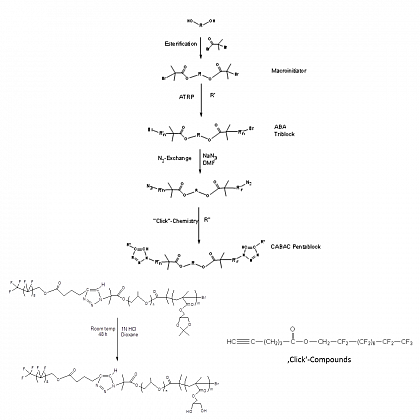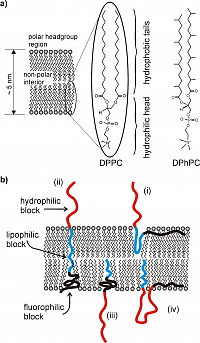Kontakt
Verantwortlich:
Prof. Dr. Jörg Kreßler
Telefon: 0345 5525800
Telefax: 0345 5527017
joerg.kressler@chemie.uni-h...
Raum 1.18
von-Danckelmann-Platz 4
06129 Halle
Postanschrift:
Martin-Luther-Universität Halle-Wittenberg
Naturwissenschaftliche Fakultät II
Institut für Chemie
Physikalische Chemie der Polymere
von-Danckelmann-Platz 4
06120 Halle (Saale)
GERMANY
Synthesis and structure formation of neutral triphilic block copolymers and their interactions with phospholipids
The aim of the project is the synthesis of triphilic (hydrophilic, lipophilic, fluorophilic) block copolymers tailored for interactions with lipid model membranes. The block copolymers are synthesized by ATRP, 'click' chemistry, and polymer analogous reactions according to the following scheme (Figure 1).

Figure 1: Schematic synthesis of triphilic block copolymers
The interactions of these block copolymers with model membranes containing e.g. 1,2-diphytanoyl-sn-glycero-3-phosphocholin (DPhPC), 1,2-dimyristoyl-sn-glycero-3-phosphocholin (DMPC), and 1,2-dipalmitoyl-sn-glycero-3-phosphocholin (DPPC) are studied by various techniques as neutron and X-ray reflectivity measurements and IRRAS (cooperation with TP 4, Blume). Additionally, Langmuir trough measurements together with Brewster Angle Microscopy and epifluorescence measurements are employed. Giant unilamellar vesicles (GUVs) are prepared and their interactions with triphilic block copolymers are studied by Confocal Laser Scanning Microscopy (CLSM). The triphilic block copolymers can organize in the membranes in different ways (Figure 2).

Figure 2: General possibilities for the organization of triphilic block copolymers in phospholipid bilayers.
The ultimate goal is the detailed understanding of the kinetics and thermodynamics of structure formation of phospholipids interacting with triphilic block copolymers.
Additionally, the interactions of liquid crystalline materials (TP 1, Tschierske) and nanoparticles (TP 2, Binder) dispersed in Langmuir films will be studied. NMR spectroscopic investigations will be carried out together with the Saalwächter group (TP 5).



